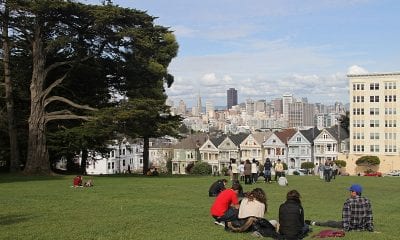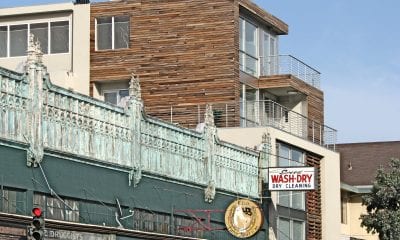Priced Out
My Father and the Betrayal of the American Dream
Co-published by Fast Company
My young father’s blue-collar jobs were his escalator into California’s middle-class. The rising cost of living has put an end to such opportunities.

There was no stopping men like my father, who began as a full-time school gardener and also worked 20 to 25 hours on weekend side jobs.
Co-published by Fast Company
My father had a dream. It wasn’t for Charlie Pape’s three boys to go to college to learn to speak with fancy words he didn’t trust. It was that each of us would buy a truck, load it up with landscaping equipment and tail him around the automotive arteries of Los Angeles, from gardening job to gardening job. “We could be,” he’d say, “Pape & Sons.”
That was to be our way to live the American Dream. But such dreams are often misunderstood. They weren’t really about the picket fence or the single-family home or, in the late 20th century, the swimming pool in Southern California. It was about economic security, quality of life and improvement; knowing that through your hard work you can provide for your own, for your future, and that your kids could look ahead to better times.
Also Read These ‘Priced Out’ Stories
For Charlie Pape this all required a preternaturally hard-work diet. First there was his full-time weekday career. He had started as a gardener for the Los Angeles Unified School District, before graduating up to supervisory roles—initially overseeing other gardeners around the district and then LAUSD’s landscaping. In those positions, he burned through two decades without using any of his sick or vacation time. And then there were the weekends when he would spend an additional 20 to 25 hours toiling on side jobs. That explained his sinewy, oversized forearms and biceps that bulged out of his white T-shirts. There was, it seemed, no stopping men like my father.
The Bargain: If you worked hard, you got ahead. If you worked harder, you might get farther ahead. In California blue-collar workers climbed the economic ladder into middle-class lives.
Why did he work so hard meticulously tending to patches of greenery in our paved-over desert city? It was, he felt, about satisfying his end of a bargain.
The other end of that bargain came from a society and an economy in which, if you worked hard, you got ahead. And if you worked harder, he believed, you might get farther ahead. His late-century California was a place where blue-collar workers spent decades climbing the economic ladder until millions of them were enjoying the fruits of securely middle-class lives.
They were, you might say, living the dream—or working on it.
American-built
Our father’s confidence in the America Dream was, in hindsight, touching and a bit odd. He was no dewy-eyed idealist. Despite his impressive muscles, he frequently prepared for the worst; he always kept an ax handle on his truck dashboard.
Born in 1941, our father came of age as America was flexing its might as the world’s dominant economic power and the benefits trickled down into his local economy. After high school, in which his only good grades tended to be in physical education and horticulture, he got a job as gardener at Hollywood High.
By the end of the 1960s he was supporting a wife and their three very young sons on a school gardener’s salary. Our family bought (and then quickly sold) three different homes, each more comfortable than the previous one—two in Simi Valley and a third in the San Fernando Valley. That last home—with its fruit trees, large yard and funky circular swimming pool in Tarzana—confirmed our arrival in the middle class of Los Angeles.
The price of such homes has risen exponentially since the 1970s and ’80s, putting them absurdly out of reach for a new generation of gardeners and school-grounds supervisors.
Our old house in Tarzana is calculated to be worth about $1.5 million. Working-class people no longer buy such homes; they maintain them.
My parents bought their starter home in 1964 on Appleton Road, Simi Valley, for $17,000 (about $136,000 in today’s currency) and is now valued by the real estate site Zillow at more than $550,000. The house that we moved to, on Tuttle Avenue a few blocks from there, was bought in 1969 for about $20,000 (adjusted to nearly $139,000 today); according to a Realtor.com estimate, it is worth at least $715,000 these days. And our former American Dream house on Santa Rita Street in Tarzana, purchased in 1974 for $46,000 ($245,457 today), is calculated to now be worth about $1.5 million. Working-class people no longer buy such homes; they maintain them.
According to the Economic Policy Institute’s cost-of-living calculator, the modern version of my dad wouldn’t do so well in the relatively low-cost Simi Valley area. The area is part of the Oxnard-Thousand Oaks-Ventura metro area, where a basket of necessities—that includes the price of fair-market housing, food, childcare, transportation, health care and other core costs—for a family of five is calculated at $11,131 per month. So for a family like ours to attain what the EPI describes as a “modest but adequate standard of living” that is a realistic “measure of economic security in America” in 2017, it would need to earn about $133,600 per year.
By the 1990s, decades of gains for blue-collar workers were being replaced by a decline that has only sped up in the 21st century.
Contrast that with the pay for the latest generation of L.A. school-system gardeners, who earn between $16 and $21 per hour these days. Today’s more common two-income households don’t come close to having the buying power that my father’s income provided in our early years.
The 2017 pay scale for my dad’s best job, as an LAUSD landscaping supervisor, was between $34 and $42 per hour, which would come out to between $71,000 and $87,000 annually, assuming it was for a full-time worker. Throw in the $20,000 or so that someone like my father might gross through his weekend gigs and it becomes clear that he wouldn’t qualify for a loan necessary to buy any of the homes our family bought—and two of those homes are in areas far less expensive than the neighborhoods where he worked.
Even if my father had continued doing all of the same work, he would have earned far less money. The sources of his income haven’t just declined in comparative terms. In his late 40s, an LAUSD shakeup forced him to accept a lower salary and, soon after, drove him into retirement in the early 1990s around the age of 50.
The Mirage
After retiring from the schools, my father initially took more gardening jobs. He could be entirely independent, out in the elements, and stay healthy. But increasingly fierce competition for gigs caring for greenery around banks and early tech companies went through a blind-bidding process. Suddenly, he found himself unilaterally lowering his own pay to keep them.
Not only do new hires have a fraction of the buying power of earlier generations, their jobs often come with limited hours that prevent workers from getting any benefits at all.
By the late 1990s decades of gains for such people were being definitively replaced by an unmistakable decline—even for an unstoppable force like my father—as the gap between workers’ incomes and living costs peaked. That gap would broaden further with the arrival of the Great Recession in 2008.
Even now, a decade later, people in my father’s position haven’t recovered. New school-system hires in gardening and landscaping have far less secure employment agreements. So not only do they have a fraction of the buying power of earlier generations, their jobs are often part-time, which prevents them from accessing any benefits at all.
My father, however, never learned about much of that. After his own material situation began to decline in the 1990s, he was diagnosed with non-Hodgkin lymphoma, a cancer of the lymph system linked to the sort of dangerous chemicals gardeners of his generation frequently used. (I previously wrote about what his experience taught me here.)
One of the hardest things he ever did was to give up his freelance gardening jobs. For a while, unable to disconnect, he’d drive around—or have his second wife drive him when he could no longer walk—to inspect “the jobs” like the supervisor he had long been.
When my own two boys look back, what are the lessons they will remember from their father?
I’d later ask him how they were looking. “Pretty shabby, Pape,” he replied. Even as his own life was crumbling, he was trying to hold up his end of the bargain as best he could.
Following two years of brutal chemotherapy my muscled-up father looked like the iconic cancer “victim.” After baseball star Darryl Strawberry met with Southern California cancer survivors in front of journalists, the photo that appeared in the newspaper was of the ballplayer alongside a large, bald man with sunken eyes and a withering physique (but improbably large forearms). It was my father, who was only in his mid-50s.
Charlie Pape died on June 2, 1999 at the age of 57.
As I tend to my own garden in Southern California’s furnace-like summer heat, I’m inundated with memories of gardening tips my father surely never dreamed I would remember. And I look at my own two young sons and wonder what they will retain, especially since I’m so much easier on them than our dad was on my brothers and me.
When they look back, what are the lessons my boys will remember from their father?
Back in the 1970s, when my brother and I helped Charlie at his biggest gig—a Great Western Bank on Topanga Canyon Boulevard with an incongruous array of flora around it—the heat would get so oppressive I would put down my reduced-size rake and seek shelter in the truck loaded with tools and an AM radio. From there, the sun-blasted blacktop sometimes seemed to smolder, creating a visual distortion.
And eventually, my father would emerge from that heated haze, knocking food wrappings and cigarette butts into a pickup pan like some sort of urban Angeleno hockey star.
In such moments—with his blue jeans, sweated-out T-shirt and unstoppable stamina—he embodied Southern California’s working-class heroes as he appeared in that mirage-like shimmer.
In the decades since, it has become clear that his dream was truly just a mirage.
Read more of our “Priced Out” series here. Please join Capital & Main’s Facebook group on the cost of living in California to discuss problems and practical solutions.
And follow Eric Pape on Twitter @ericpape, and let him know if you have a powerful story about the human impact of high prices in the Golden State.
Copyright Capital & Main
-

 State of InequalityApril 11, 2024
State of InequalityApril 11, 2024Dispelling the Stereotypes About California’s Low-Wage Workers
-

 Latest NewsApril 24, 2024
Latest NewsApril 24, 2024An Author Reflects on the Effort to Rebuild L.A. After the ‘Violent Spring’ of 1992
-

 State of InequalityMarch 28, 2024
State of InequalityMarch 28, 2024Los Angeles Hotel Workers Could Use the 2028 Olympics to Their Advantage
-

 Striking BackApril 12, 2024
Striking BackApril 12, 2024Organizing the Slopes
-

 State of InequalityApril 25, 2024
State of InequalityApril 25, 2024California Often Leads Change, but Not for Single-Payer Health Care
-

 Feet to the FireMarch 29, 2024
Feet to the FireMarch 29, 2024New Mexico Governor Vetoes Tax Break for Wells After Pushback
-

 The Heat 2024April 15, 2024
The Heat 2024April 15, 2024Climate + Young Voters = Biden Victory, Right? It’s More Complicated Than That.
-

 Striking BackApril 26, 2024
Striking BackApril 26, 2024At Occidental College, Upcoming Vote Reflects Rise in Undergraduate Labor Organizing














